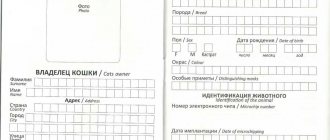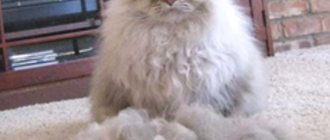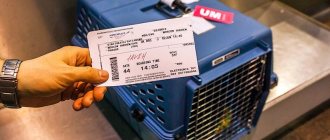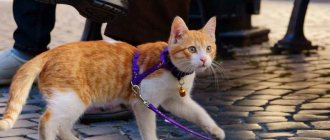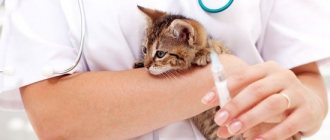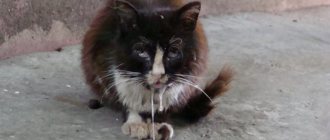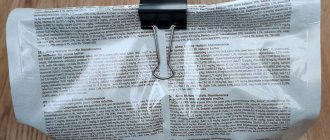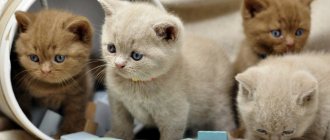The world is open to everyone, not only for people, but also for animals. Sometimes the fate of a person and a pet depends on the official card. A veterinary passport for a cat will help when visiting a doctor, changing place of residence or traveling abroad. Requirements for veterinary documents vary in each country, but cats will be saved from quarantine, loneliness, new vaccinations and other troubles if such a certificate or certificate is available and correctly filled out.
Types of veterinary passports
A veterinary passport is a registration certificate for a pet, which contains the history of vaccinations, the type of animal, and information about the owner.
It happens:
- domestic model, valid where the owner and the pet live;
- an international standard (or an international veterinary vaccination certificate), which allows you to import an animal into another country, and the entries here are in both your native and English languages;
- universal pattern, suitable for all types of pets, such as cats, dogs, ferrets.
In document forms from different manufacturers, differences in appearance and number of pages are acceptable.
Microchipping a cat
A good method that will prove that the cat is yours and no one else’s is microchipping. To do this, an electronic chip or simply a carrier is sewn under your pet’s skin. However, this technique is mainly used by owners of purebred animal species. This is a kind of electronic passport, which can be used to restore all data if suddenly the paper form is lost or something happens to it.
Mostly owners of purebred animal species resort to microchipping.
But keep in mind that microchipping itself is expensive and not everyone can afford it. Typically, the cost of such a procedure ranges from 600 to 1500 rubles.
Why do you need a veterinary passport?
It is required for:
- reminders about the timing of the next vaccination;
- traveling around Russia or to other countries (according to an international document, the veterinary government service issues a certificate for traveling abroad);
- overexposure of a pet in a hotel for animals (health and vaccination records indicate that it can safely live next to neighboring guests).
What to do if the international veterinary passport is lost
A passport can get lost
A passport can easily get lost during a trip, outing, in the forest or in the city. If the document could not be found immediately, you will have to fill it out again.
Be sure to contact the organization that issued it. The easiest way is if the dog has a chip - its data is stored in the veterinary clinic, and the animal’s data can be easily restored using it. If there is no chip, then you will have to carry out all the procedures again. In order not to harm the dog, it is better to time the restoration of documents to coincide with the date of the next vaccination.
Full information about the preparation of veterinary documents, examples of prices and addresses of clinics in your region must be clarified separately. Typically, experienced dog breeders share such important data with each other and have their own ratings of veterinary clinics and doctors.
Where do you get the form?
- Can be purchased at any pet store, online store, pet pharmacy, veterinary clinic.
- Receive from a veterinarian in a veterinary clinic or at home during the first vaccination.
- The document is issued by the breeder when purchasing a kitten from the nursery.
The cost of an international certificate is slightly more expensive than usual, 100-150 rubles. Animal owners often prefer universal international certificates.
Choosing the gender of the kitten
Choosing a gender ceases to be difficult if you clearly understand the purpose for which you are purchasing a pet. If a British kitten is purchased as a pet, without the prospect of participating in breeding work, then it does not matter much whether it is a cat or a female cat. Typically, the breeder recommends sterilizing such an animal and has the right to include a corresponding condition in the contract if he does not want the kitten to participate in breeding work in the future.
Quite often the practice is to sell already sterilized kittens . In this case, they choose the baby who is liked more than the others, is more active, and has some special features that distinguish him from other brothers.
Important! If the new owner has to decide on the issue of sterilizing the pet himself, it should be taken into account that with approximately the same degree of complexity and cost of operations, regardless of the gender of the kitten, the postoperative period in cats lasts 3-5 days longer.
If a kitten is purchased for breeding, the question of sterilization is removed: the pet, regardless of its gender, needs regular matings throughout its active life. The main difficulties for the owner lie in maintaining breeding animals.
- The behavior of a cat characteristic of the mating season, if mating does not occur, can only be tolerated by an absolutely insensitive person. This situation can be leveled out by timely selection of a worthy partner (on your own or with the help of the club where the cat is registered) when the time for the planned mating approaches. At this point, the cat must be vaccinated against infectious diseases.
- Breeding cats need the company of partners every month, and in their absence they lose their conditioning qualities, become irritable and, what is especially unpleasant, begin to leave marks. As a rule, the cat's owner becomes the receiving party for mating. He is also responsible for the health and life of the arriving guest, providing an area for courtship so as not to disturb the animals.
If these points are not a priority when choosing a kitten, the owner should know that gender affects the size and development of an adult animal: British cats are imposing, massive, textured, while female cats are more miniature and dynamic. And, of course, you need to take into account the character traits of the cat.
Important! But regardless of gender, a pet will always feel the need for love and attention from a person.
British gentlemen are distinguished by their discreet friendliness towards all family members, their self-sufficient character and are completely unobtrusive. Ladies are more capricious and selective in their habits and behavior, while being unusually clean, smart, attached to one person (usually a man), sometimes showing jealousy and possessive feelings.
Return to content
Who fills out the veterinary passport and how?
The owner can enter information about himself and the pet, or the doctor can enter information about himself and the pet when registering the animal before vaccination.
Fields for self-entering data:
OWNER OF ANIMAL
"FULL NAME. / Name” – the owner indicates the full name, surname.
“Address” – if the kitten was registered to a breeder, then after purchase the owner changes all the breeder’s information to his own.
DESCRIPTION OF ANIMAL
“Type of animal” – if the cat is purebred and has a metric, then it is filled in as in the pedigree.
For example, like here for the sphinx:
“Pet's name” - is given according to the metric; for outbreds - their own nickname.
“Breed” – for outbred animals it is written “mixed breed” or “mongrel”.
“Date of birth” – if it is not known exactly, it is indicated approximately.
“Gender / Sex” – one of the options: “female”, “male” or tick “v”.
“Pet photo” – paste any photo without printing.
“Color” – write it as in the metric, or make a description yourself.
“Special signs / Distinguishing marks” – if any.
Choosing a kitten class
British cats within the breed are divided into the following quality classes.
- Show . Representatives of which have an impeccable pedigree and fully or as closely as possible correspond to the breed standard. Kittens in this category are the most expensive: in the future they become owners of prestigious titles and awards, and excellent producers.
- Breed . Of interest to breeders. Having minor flaws in appearance, British kittens of this class are, nevertheless, excellent for further breeding work. They are purchased for breeding due to rare phenotypic traits that will be passed on to future offspring.
- Pet (pet), or simplified breed . A class whose representatives are purchased as a pet, “for the soul.” Due to minor flaws and defects (for example, white spots, medallions), such kittens do not meet the requirements of international standards. The cost of these babies is significantly lower than kittens of the “show” and “breeding” classes.
Return to content
British Fold kitten price
Extensive selection work, active popularization and promotion of the British breed have somewhat reduced the initially exorbitant prices for kittens. But the priority pricing factor is still the quality class of the pet. The most expensive and prestigious are representatives of the “show” category: the minimum price for them ranges from $300 to $600. A breed class pet will cost $150-$160 less. A purebred “pet” kitten can be purchased for $150-$200.
We should also talk about buying a British Fold kitten. The paradox is that the breed is not officially registered by any felinological organization, but advertisements for the sale of such babies are quite common. We are talking, apparently, about mixes from a British cat and a Scottish fold cat.
Important! Such matings were previously allowed, but led to the fact that British-type kittens received elongated body proportions, while Scottish kittens received more massive bones. The risk of congenital anomalies in individuals resulting from such marriages is also high.
In general, this origin does not make the kittens less charming than the genetically “correct” British, but it does indicate that breeders in their work neglect the ban on interbreed marriages, control of matings and birth rates. The cost of British fold kittens is quite modest - about $100, they are purchased only as a pet: such animals will never have a pedigree and the right to participate in exhibitions, as well as in further planned breeding.
Return to content
Choosing a healthy kitten
The very fact of purchasing a British kitten from a specialized nursery is already a kind of guarantee that the baby is healthy and normally developed. In good nurseries, where breeders are responsible for breeding the breed, all matings are planned, there are no accidental litters, reliable information about the use of the kitten’s parents and other ancestors in breeding work excludes severe hereditary defects and diseases.
However, the new owner must make sure for himself that he is acquiring not only a purebred animal, but also a healthy one . To do this, when meeting the baby, you need to examine him and observe how he behaves. Important criteria to pay attention to first.
- The characteristic dense plush fur should be shiny and evenly textured, without bald patches or matted tangles. The presence of fleas and skin diseases are indicated by small black grains - parasite excrement, scratching and rashes.
- The ears should be clean, without dark plaque on the inside of the shell and discharge from the ear canal - symptoms of ear mite infestation.
- Up to a year old, a small British baby has slight discharge from the eyes. But under no circumstances should they be cloudy or purulent. A healthy kitten's eyes are clear and well open.
- You need to make sure that there are no ulcers or abnormally developing teeth in your mouth. Depending on the nature of the pigmentation of the mucous membranes, not all cats' gums are pink, but in any case they should not show signs of inflammation.
- The nasal planum of a healthy kitten is smooth, shiny, without traces of discharge from the nasal passages.
- The tummy, even if the baby has recently dined, should not be bloated and hard.
- Clean, dry fur under the tail, absence of swelling and signs of inflammation around the anus are evidence that the baby’s digestion is fine.
- Careful palpation of the tail should not reveal any knots or creases.
It is also worth making sure that the baby is active and moves well. You can try to play with him, while at the same time observing the reaction to a stranger. The more confident and free the kitten behaves when first meeting him, the easier and faster his adaptation to the new environment will be.
Return to content
